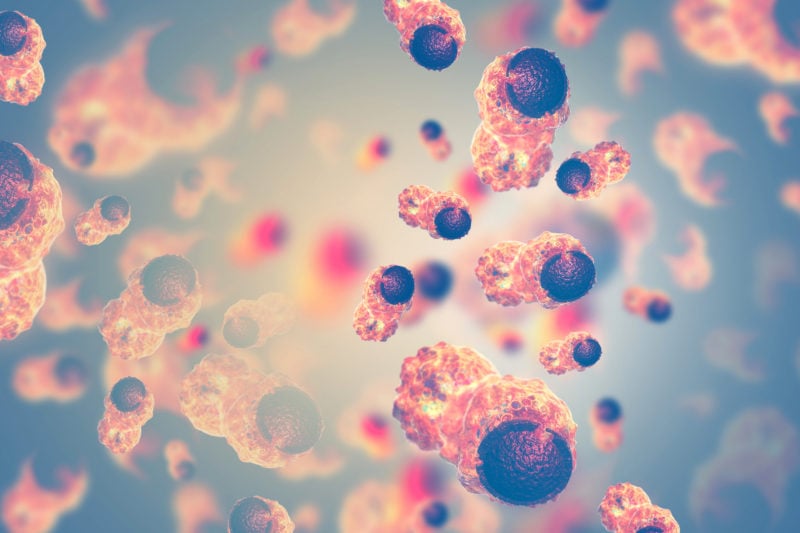Cancer is, at its core, cell growth run amok. Although we now know that genetic mutations are often responsible for a tumor’s genesis, how that tumor grows and spreads results from cancer’s unique metabolism, including its ability to use large amounts of glucose.
While early breakthroughs in understanding cancer’s metabolic machinery happened almost 100 years ago, in the past decade, researchers have begun diving back into the role of glucose, insulin, and other metabolic hormones and pathways in tumor formation and growth. This resurgence could stem from increasing epidemiological evidence that obesity and diabetes are risk factors for certain cancers, sparking interest in the possible role of metabolic disorders.
Here’s a look at how cancer interacts with our metabolic systems, what it means for particular types of cancer, and what that might mean for future treatments.
Learn more:
The History of Cancer as a Metabolic Disease
The idea of cancer as a genetic disease didn’t really begin until 1971 when the first oncogene—a type of mutated gene that can cause cancer—was discovered. Researchers have since found around 300 human oncogenes. We now understand that genetic mutations and metabolic processes (along with other factors) drive cancer growth. However, before the 1970s, cancer was widely thought of as a metabolic disease, largely thanks to the observations of German physiologist Otto Warburg.
“Stricter glycemic control measures could help reduce the risk for cancer incidence and mortality.”
In 1924, Warburg noticed that tumors consume more glucose and release more lactate than normal cells do. Lactate is an end product of glycolysis, a relatively inefficient metabolic process by which cells convert glucose to energy without utilizing oxygen (anaerobic metabolism). Warburg’s team found glycolysis happening in cancer cells even when there was plenty of oxygen to convert glucose to energy via the normal process of aerobic metabolism in the cell’s mitochondria. This became known as the Warburg Effect, and Warburg won the 1931 Nobel Prize in Physiology for the discovery.
Why Cancer Loves Glucose
Ever since Warburg’s discovery—and particularly in the past 10 years—scientists have been trying to understand cancer’s propensity for glycolysis. It seems counterintuitive given that for every unit of glucose, glycolysis only nets two ATP molecules, whereas mitochondrial respiration produces 36. Why would cancer cells choose such an inefficient mechanism to generate energy?
Several theories have emerged that may help explain the success of cancer and shed light on new treatment options, from drugs to diet. A recurring theme is how cancer cells adapt their metabolism to ensure survival in a competitive tumor microenvironment, which may include low oxygen levels within a tumor and competition for nutrient resources. This is where glycolysis may prove essential, both in providing cancer cells a way to make energy in a low oxygen environment and because each of the ten stages involved produces molecules that support tumor fitness in different ways.
Other research points to a vital role for the surge of lactate generated by glycolysis in cancer cells. Once thought to be just a waste product, research shows that it also acidifies the tumor microenvironment, which may ward off many of the surrounding immune cells, clearing the path for the tumor to spread. Another recent study suggests lactate may also induce epigenetic changes in immune cells known as macrophages in ways that support tumor growth.
Another critical factor is that glycolysis happens a hundred times faster than respiration, meaning cancer cells use glucose extremely rapidly. Such voracious glucose consumption could benefit cancer cells by depriving nearby immune cells of the glucose they need to fuel their fight against the tumor.
Researchers are still investigating ways to stop tumor growth by targeting specific parts of glycolysis, but the complexity of cancer’s highly adaptive metabolism remains challenging.
Learn more:
How Metabolic Health Impacts Cancer
Hyperglycemia and Insulin Resistance
Cancer risk is higher among people with hyperglycemia, a state of elevated blood glucose commonly associated with diabetes. However, this meta-analysis found that risk for several cancers increases even at A1c levels below diabetic (6.5%)—in some cancers, the risk started increasing even below 5%, considered “normal,” and rose as A1c rose. The authors conclude that more study is urgently needed, as “stricter glycemic control measures could help reduce the risk for cancer incidence and mortality.”
Sustained high blood sugar may not be the only contributor. A study of nearly 5,000 adults with Type 2 diabetes revealed that people with Type 2 diabetes whose fasting glucose levels varied by more than 25% over around five years were almost three times more likely to develop cancer. A similar long-term study of more than 42,000 people in Japan without diagnosed diabetes also reported increased cancer risk among those with highly fluctuating blood glucose as measured by changing A1c levels.
All of these studies suggest that maintaining steady, healthy glucose levels could lower cancer risk, even in nondiabetic individuals. This is important, because our conventional approach to blood sugar is to not focus on it until you have a diagnosis of prediabetes or diabetes, and yet research suggests that maintaining steady glucose could be helpful even for nondiabetic individuals.
So how exactly might hyperglycemia affect cancer? First, hyperglycemia triggers an inflammatory response, which tumor cells can take advantage of in numerous ways to grow and spread to other parts of the body. For example, inflammation increases the permeability of blood vessel walls to let immune cells into damaged tissues, where they can help tumor cells sneak out into the bloodstream. The body also produces more platelets that help immune cells exit blood vessels to go to sites of inflammation, and tumor cells can latch onto these platelets for protection on their journey through the bloodstream.
Hyperglycemia may also decrease the efficacy of cancer treatment by interfering with the pathways by which chemotherapy and cancer drugs typically work on tumors. It also reduces the response in immunotherapy, though the causes are not fully understood. Researchers are exploring combining cancer therapy with anti-hyperglycemia drug metformin, but more extensive trials are needed to test this.
Hyperglycemia can also lead to insulin resistance. Insulin is the hormone that signals for cells to take up glucose to be turned into energy. However, consistently high blood glucose can stop normal cells from responding to insulin appropriately. The pancreas then releases more insulin to try to compensate and get the glucose into the cells. Unfortunately, if a person has insulin resistance, the body will produce excess insulin in response to glucose and be in a state called hyperinsulinemia. This has been connected to several obesity- and diabetes-related cancers and higher general cancer mortality.
People with insulin resistance have higher levels of circulating insulin and higher levels of free insulin-like growth factor 1 (IGF-1), a related growth hormone. Many cancer cells have increased receptors for insulin and IGF-1, and both hormones promote cell growth and proliferation. Both also interfere with the normal process of cell death, called apoptosis, which contributes to cancer’s spread.
High blood glucose and hyperinsulinemia can enhance the growth and migration of cancer cell lines. Under lab conditions, persistently high glucose and insulin levels caused cell lines from a variety of cancer types to grow faster and travel further from their initial location.
Hyperinsulinemia and inflammation are thought to be indirect ways in which hyperglycemia contributes to tumor growth. Still, researchers are also looking at ways hyperglycemia directly impacts cancer cells’ proliferation, spread, and invasiveness by triggering specific pathways and hormone signals.
Levels Member Experience:
Obesity
In 2018, more than 40 percent of adults in the USA were obese, and around 10 percent had diabetes. There is now considerable evidence that being overweight or obese as an adult increases the risk of certain cancers, including breast, colorectal, endometrial, kidney, liver, and pancreatic. The connection between excess body weight and cancer is a global issue with regional variation. In the UK, obesity and overweight are the second leading cause of cancer, after smoking tobacco, and accounts for 1 in 16 of all cancer cases (6.3 percent).
And in America, a study of more than 300,000 generally healthy non-smokers found that, over a 14-year period, estimated that for adults over 50, as much as 14 percent of America’s cancer deaths in men and 20 percent of those in women could be due to being overweight or obese.
So how can obesity contribute to and exacerbate cancer? There are several possible mechanisms across different types of cancer, but two leading factors are inflammation and insulin resistance. Obesity and insulin resistance are tied together in a cycle, with excess free fatty acids interfering with glucose processing and inhibiting insulin response, which triggers more insulin. At the same time, insulin resistance interferes with the body’s ability to process fat for energy, which leads to more free fatty acids. As discussed above, insulin resistance and hyperinsulinemia can promote cancer formation and spread, as insulin (and IGF-1) encourages tissue growth.
People with obesity commonly have excess fatty molecules called lipids in their blood, which cancer cells use to fuel growth, and high -levels of certain lipids have been linked to shorter survival times in men with prostate cancer. In addition, adipose (fat) tissue produces hormones, such as estrogen, that can promote tumor growth. And on top of these risks, people who are overweight are more likely to develop insulin resistance, which can turn into Type 2 diabetes.
Inflammation
Many metabolic conditions, including obesity and hyperglycemia, can create a state of chronic, low-level inflammation. Inflammation can promote cancer development and exacerbate the growth of existing cancer through several mechanisms, including DNA damage. Inflammation is an immune response, so in states of chronic inflammation, the body is primed to repair presumed injuries or wounds. Tumor cells can exploit the activation of these pathways to promote tumor growth.

Inflammation and glucose levels: How high blood sugar can turn a good system bad
Inflammation helps heal your body, but chronic inflammation can cause serious damage. Here’s how a healthy lifestyle—including a low-sugar diet—can help keep it in check.
Read the ArticleDiabetes
Given the links between cancer and insulin resistance, hyperglycemia, and obesity—all factors linked to Type 2 diabetes—it’s no surprise that diabetes is now widely accepted as a risk factor for developing and dying from cancer. Among one million American adults, diabetes increased the risk of death from cancers of the liver, pancreas, colon, and breast and cancer of the mouth and throat.
As for what drives the connection between diabetes and cancer, it is, again, often the dangerous duo of hyperglycemia and insulin resistance. Like obesity, diabetes disrupts fat metabolism, causes chronic inflammation, and puts oxidative stress on normal cells that can damage DNA, leading to genetic errors. And no matter how a tumor emerges, cancer cells in people with diabetes often have access to a surplus of glucose because of impaired insulin signaling.
The Cancers Most Associated with Metabolic Disorders
Colorectal Cancer
The digestive tract is particularly prone to developing cancer. Colorectal cancer is the third most common cancer and is more likely to develop in people with insulin resistance and diabetes. Colorectal cancer mortality is also higher in patients who eat a diet heavy in insulin-spiking foods. An analysis of multiple studies including nearly 3,000,000 people worldwide found that every 20mg/dL increase in fasting glucose increased the risk of colorectal cancer by 1.5%.
When mice that were predisposed to develop tumors were given unlimited access to drinks sweetened with high-fructose corn syrup, they developed larger, rapidly worsening polyps in the colon independent of obesity. In rats, hyperinsulinemia increased the growth of colorectal cancer, although hyperglycemia did not worsen the effects, suggesting that insulin plays the leading part. Researchers have found that the insulin and IGF-1 signaling system plays a role in colon cancer among other potential mechanisms.
Liver Cancer
Metabolic diseases are a significant risk factor for non-alcoholic fatty liver disease (NAFLD), in which excess fat builds up in the liver. NAFLD is often a result of a high-fat diet, though it may be sped along by excess consumption of fructose, which increases the production of fat molecules in the liver. NAFLD can cause chronic low-level inflammation, a major risk factor for one of the most common types of liver cancer. The precise molecular mechanisms remain unclear, although recent research suggests inflammation in some cases of NAFLD helps turn immune cells against the body.

Why fructose is bad for metabolic health
Is fructose bad for you? Fructose is a natural sugar, but as an added sweetener, its metabolic impact can be severe.
Read the ArticlePancreatic Cancer
Pancreatic is one of the most lethal cancers: only around 10% of people with pancreatic cancer survive beyond five years. Many patients also suffer from cachexia, a muscle- and fat-wasting disease, which may be due to the long-term insulin resistance and diabetes that often precedes pancreatic cancer and is exacerbated by factors produced by the tumor. Conversely, pancreatic cancer can also cause diabetes in people who did not have it before, which sometimes causes weight loss even before cachexia sets in. Pancreatic cancer becomes particularly lethal once it metastasizes, and unfortunately, it is not usually detected until this stage. The spreading tumor develops mechanisms to alter its gene expression to take up glucose more rapidly.
Breast Cancer
Diabetes could increase the risk of developing breast cancer by 17% in post-menopausal women. One possible reason is that breast cancer cells have six times more insulin receptors than their healthy counterparts, enabling them to take advantage of the high glucose levels that accompany diabetes. Looking into the molecular mechanisms, one study found that high glucose levels reduce the numbers of a tumor-suppressing molecule called miR-424, thereby enabling enhanced growth and invasiveness of breast cancer cells.
Obesity is also a strong risk factor, particularly post-menopause. Fat tissue produces estrogen, and given that breast tissue is very sensitive to estrogen, an excess in the blood can promote breast tissue growth. This may explain why postmenopausal women with excess body fat have a greater risk of breast cancer than lean women.
Endometrial Cancers
Cancers of the uterine lining, or endometrial cancers, are closely linked to environmental risk factors and lifestyle, including lack of physical activity, obesity, and related metabolic syndrome. Population studies suggest that around 40% of endometrial cancer cases in industrialized countries are caused by excess body weight. As with breast cancer, this may be due to the increased estrogen supplied by fat tissue. Hyperinsulinemia is also a common cause of polycystic ovarian syndrome (PCOS), a metabolic disorder associated with insulin resistance. One large cohort study in Taiwan showed that women with PCOS were 17 times more likely to develop endometrial cancer.
Prostate Cancer
Men with diabetes are less likely to develop prostate cancer, but conversely, the death rates are higher among men who have both. This may be in part because prostate cancer cells in men with diabetes have far more insulin receptors than those in men without diabetes. In a study of more than 17,000 Finnish men, diabetes-level fasting blood glucose raised the risk of prostate cancer. A fat-enriched diet is also related to molecular changes in animal models that have the potential to spur cancer growth.
Potential Metabolic Cancer Therapies: Drugs and Diet
The various complex mechanisms behind the role of metabolism in cancer are yet to be fully explained, but there is strong evidence for the role of phosphoinositide 3-kinases (PI3K), a group of enzymes that are essential for cells to use insulin throughout the body. It can be mutated in human cancer cells, where it helps sustain glycolysis to promote rapid cell growth. Indeed, PI3K is already under investigation as a potential cancer drug target.
However, blocking PI3K signaling causes hyperglycemia because it tampers with the body’s ability to use insulin to regulate glucose levels. Unfortunately, more insulin simply reactivates the enzyme, leading some researchers (including Lewis Cantley, who helped discover PI3K’s role in tumor growth) to suggest that the hyperglycemia be managed through drugs or dietary changes rather than extra insulin. Numerous other drugs that disrupt cancer metabolism are under investigation, and more than 50 drugs targeting the PI3K pathway are in development.
One drug being looked at is metformin, an anti-diabetic drug used for decades to reduce glucose and insulin levels. Numerous studies suggest that metformin reduces the heightened risk of cancer in diabetic patients compared to other anti-diabetic drugs, though results vary between cancer types. A study of women with breast cancer found the benefit was limited to those using metformin for more than five years.
There is growing interest in complementing conventional cancer therapy with a diet that controls the nutrients available to the cancer cells. For example, nutrient restriction limited the growth of a range of cancer cells in the lab, while a combination of fasting and hormone therapy in mice with breast cancer reduced insulin levels sufficiently to reduce tumor growth. However, depriving cells of nutrients could harm the rest of the body, so following a time-restricted eating schedule without cutting back your total intake may be more beneficial.
Another option is expressly depriving cancer of its favorite food, glucose. But cancer cells also use amino acids, such as serine or glutamine, to make molecules that it needs to grow, suggesting a need to simultaneously block these metabolic pathways. The ketogenic diet (alongside traditional therapies) has shown positive effects on tumors in animal models, and most cancers seem unable to metabolize ketone bodies. Still, we need more large, randomized trials to understand its impact on specific cancers.
The Takeaway
The last decade of research has unleashed a torrent of new information about cancer’s relationship with glucose, and we’re learning more all the time. Cancer is far too complex to be solved by any one diet change, but there’s evidence that some metabolic disorders like diabetes and obesity can increase our risk of developing certain cancers. Diet and lifestyle choices that promote stable glucose can help us maintain optimal metabolic health.
Dive Deeper
Here are some of our favorite studies on the relationship between cancer and metabolic disorders.
- The Warburg Effect: How Does it Benefit Cancer Cells?
- Hyperglycemia, a Neglected Factor during Cancer Progression
- Obesity as a Major Risk Factor for Cancer










